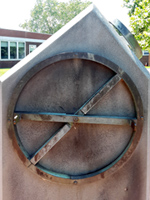|

|
Annapolis
|
Sundial: 1036
|
| State/Province: Maryland |
Country: USA |
| Dial Type: Noon Mark or Meridian Dial |
Condition: Good |
| |
Latitude and Longitude: |
38° 58.927' N 76° 29.547' W |
| Location: |
- On the campus of St. John's College, southeast of McKeldin Planetarium, in front of Mellon Hall on a small, circular brick plaza.
|
| |
| Description: |
- This brass mariner's compass about 12 inches in diameter is mounted on the east side of a concrete pillar. It is known on campus as "The Ptolemy Stone". It functions as a meridian transit with altitude marks every half degree engraved on the upper south quadrant. The alidade has a notch on the upper end and a plate at the lower end, designed for measuring the altitude of the sun using the notch shadow (preventing eye damage of sighting the sun directly). The pillar is just over 3 feet tall with a sloped top. The main slope is that of the site latitude. A steeper "north face" is cut plane to the celestial equator. To make the equator "visible", a ring is mounted to the face. The ring casts no shadow on the equinox and from September to March is in shadow. A similar Ptolemy Stone is at St. John's campus in Santa Fe, NM.
|
| |
General Information: | - Owner: St. John's College
|
|
|
- Construction Date: circa 1987 or earlier
|
| |
| References: | Web Links: |
- St. John's is one of the oldest academic institutions in the US, a successor to King William's School founded in 1696. SJC received a collegiate charter in 1784, providing a liberal arts education based on Great Books curriculum.
| |
Last Revised: 2021-12-09 15:20

